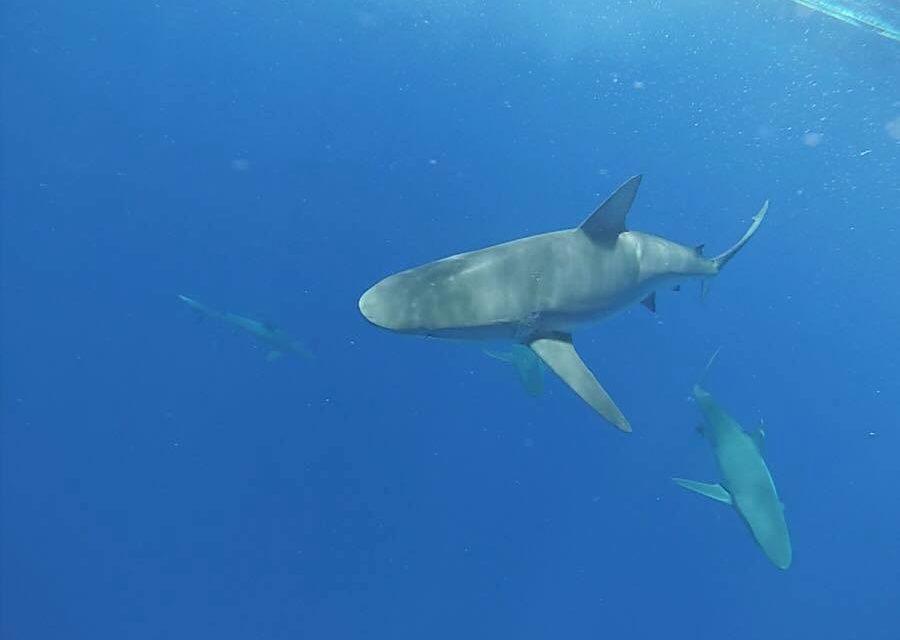By Sarah Hendrix | Staff Writer
October has arrived and in most places around America that means pumpkin spice lattes, Halloween decorations and fall festivities. Hawaiʻi also does its best to participate in these activities, but in reality no one feels like drinking a pumpkin spice latte when the temperature still reads 80 degrees.
Instead, I’m usually at the beach on weekends, surfing until sunset and carrying on with my regular summer water sports despite my fear and acute awareness of the shark attacks that happen in Hawaiʻi during the month of October.
My fascination with shark attacks didn’t begin until I started surfing in 2015. Up until that point I found myself grouped in with the general population, not thinking twice before I enter the ocean. I thought it was more adventurous to stray away from the crowd and swim alone, and I loved staying in the water from dusk well into the night. I was completely unaware that I was breaking the first two safety tips to reduce shark injury given by the Division of Aquatic Resources in the Hawai‘i Department of Land and Natural Resources. The first being to always stay close to other people in the water, and the second to stay out of the ocean at dawn, dusk and night because those are feeding times for sharks.
It was October 2015 when my husband and I packed our boards and headed down to Diamond Head for a sunset surf session. We were just about to jump into the water when a surfer coming in stopped us and said that a bunch of people had spotted a shark and everyone was getting out of the water. We were both disappointed but knew that surfing was not worth the possibility of running into a shark. Up until that moment I hadn’t given much thought to the creatures that could be swimming below us while we were out in the water.
That month I began researching shark attacks in the Hawaiian islands. My fear drove me to scour every available website with information on anything shark-related. I wanted to know what species of sharks were in Hawaiʻi, where the recorded attacks happened, and what the statistics were of getting attacked by a shark.
The state of Hawaiʻi had recorded all shark attacks in the Hawaiian islands dated back to 1980. In the records, it was easy to see that the amount of attacks had dramatically increased since 2012. Most of these attacks were from tiger sharks or reef sharks, and had happened throughout the Hawaiian islands. One statistic that eased my growing fear of sharks was when I found out that I am actually more likely to die in a car accident on my way to the beach then I am of getting attacked by a shark.
Ironically, only days after I had been researching, the first shark attack happened. During the month of October 2015, three separate shark attacks happened in Haleiwa, Kailua and Makaha. All three attacks were from tiger sharks on different beaches around Oʻahu. Each attack was around a week and a half apart: the first attacked a surfer, the second a swimmer and the third a body-boarder.
At that point I really wondered why I was surfing at all. It felt like getting into the water was asking for trouble. But I continued to see people get back into the ocean. Some of them were born and raised by the ocean and they were not paralyzed with fear thinking that a shark attack could happen. Instead they seemed more aware than I had ever been. When they surfed they stayed with people out in the water, they never wandered off by themselves.
In Hawaiʻi avid surfers, divers, body-boarders and swimmers know the increased risk they take when getting into the ocean from the months of October-December. According to the DNLR, their charts show since 2012 there has been an increase in the number of shark attacks happening in the Hawaiian islands primarily in the month of October. There isn’t one specific reason for the increase during that time of year, but the trends have shown that the largest number of attacks have happened on Maui. Since 2010 there have been 30 reported sharks attacks on Maui, 11 on Hawaiʻi, 8 on Kauaʻi, 7 on Oʻahu, and 2 on Lānaʻi totaling 58 shark attacks in the Hawaiian islands in the past 7 years.
I had realized after doing the research and hearing about the attacks that my biggest fear had been my own unawareness. For the years I had swam in the ocean before, I had not been smart out in the water. My mind changed when I realized that when I enter the ocean I am entering a shark’s territory. That I need to show respect and have an awareness for whose home I am entering.
My newfound knowledge of shark attacks did not give me an unhealthy fear of the ocean or prevent me from surfing again, but it gave me awareness and respect for when I am out in the water. Since then I have continued going to the beach on weekends, and still love surfing at Diamond Head.
Just the other day as I was paddling out at Diamond Head, I started talking with an uncle who jumped in the water at the same time. As we paddled out, we talked about the waves and how perfect the conditions were. Then at one point he got very quiet. He was looking out at the waves for a few seconds before he turned back to me. With a slight grin on his face and wide eyes he said, “I just saw a fish.” In that moment I didn’t have the guts to ask him to define what he meant by “fish.” Instead I kept paddling out, determined to stick as close to him as possible.






